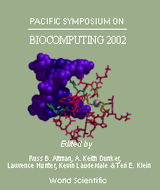Pre-mRNA secondary structure prediction aids splice site prediction
Patterson DJ, Yasuhara K, Ruzzo WL
University of Washington, Box 352350, Seattle, WA 98195, USA.
Pac Symp Biocomput. 2002;:223-34.

Abstract
Accurate splice site prediction is a critical component of any computational approach to gene prediction in higher organisms. Existing approaches generally use sequence-based models that capture local dependencies among nucleotides in a small window around the splice site. We present evidence that computationally predicted secondary structure of moderate length pre-mRNA subsequencies contains information that can be exploited to improve acceptor splice site prediction beyond that possible with conventional sequence-based approaches. Both decision tree and support vector machine classifiers, using folding energy and structure metrics characterizing helix formation near the splice site, achieve a 5-10% reduction in error rate with a human data set. Based on our data, we hypothesize that acceptors preferentially exhibit short helices at the splice site.
[Full-Text PDF] [PSB Home Page]